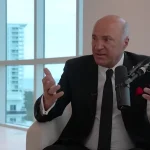
In the noisy world of personal finance advice buzzwords, hot stocks, and speculative crypto, Kevin O’Leary brings something refreshingly simple. One core rule that small investors can follow to build substantial wealth.
In a recent interview with The Street Roundtable, O’Leary distilled wealth creation into a foundational practice: save before you spend, invest wisely, and let time compound your gains.
Small in appearance but massive in consequence, this rule shifts the investor’s mindset away from instant gratification and toward disciplined accumulation. Here’s how O’Leary frames the path—and how you can apply it.
The Rule: “Don’t spend it. Save it. Invest it. Let it Compound
At the heart of Kevin O’Leary’s counsel lie three simple verbs: save, invest, and compound. He frequently states, “The market gives you the gift of compounding if you enable it.”
His commentary covers the fundamentals:
- Dedicate a meaningful portion of income to investment—various outlets cite a target figure of 15% of your income.
- Rein in your spending; every latte, impulse purchase, and needless subscription chips away from capital that could be invested instead.
- Pick investments that make sense for your time horizon and risk tolerance—then give them time, rather than chasing quick flips.
In a world obsessed with “get rich quick,” O’Leary argues the real path is gradual, steady, and most importantly, owned. He puts it plainly: “A $28 lunch one day can translate into $800,000 less in your portfolio 30 years from now thanks to interest compounding.”
Why It Works: The Magic of Compounding & Discipline
O’Leary’s rule isn’t romantic; it’s rooted in long-term capacity, not shortcuts. Here’s what supports it:
1. Time Is The Multiplier
The earlier you begin, the more years your capital has to grow and compound. O’Leary demonstrates that even modest contributions and years of investing 15% can turn into million-dollar portfolios over the decades.
2. Spending Eats Growth
Discretionary spending that seems minor—expensive lunches, fashion trends, and subscriptions—becomes significant when viewed through the lens of lost investment opportunity. Kevin underscores this frequently.
3. Investment Over Speculation
The rule demands investing, not gambling. Rather than betting on hot tips or hype-driven assets, O’Leary emphasizes disciplined and diversified investing aligned with one’s goals.
4. Behavior Matters Most
Even the best investment won’t succeed if you abandon it at the first downturn. Kevin emphasizes consistent behavior, staying the course over timing market peaks.
What Does Kevin O’Leary Really Mean?
While the ‘15% rule’ and ‘compound your investments’ sound simple, O’Leary’s commentary contains deeper layers worth unpacking:
- Start with income, not luxuries: The conversation isn’t about living on rice and beans. Instead, it’s about spending with awareness and directing more to savings when possible.
- Own your process: Investing isn’t a one-time event. Kevin continues to remind you that you’re building something over the years, not weeks.
- Tailor to your situation: The “15% rule” is illustrative and not dogmatic. He acknowledges that real-life costs, debts, and priorities matter. The core is having a number and consistently hitting it.
- Diversify and hedge: He recommends diversifying across assets and avoiding “big bets.” This structural discipline works alongside the savings-and-investment rule.
How to Translate the Rule Into Action Today
Kevin’s rule can feel daunting; however, it’s actionable. Let’s break it down:
Step 1: Pick A Savings-Investment Target
Decide if you are saving 10%, 15%, or 20% of your income. Write it down. Automate it. Treat it like a non-negotiable expense.
Step 2: Audit Your Spending Habits
Look at your recurring expenses. Ask: What could that amount be worth if invested? O’Leary emphasizes replacing “consumption” with “investment first.”
Step 3: Choose Investment Vehicles Aligned To Time Horizon
If you’re decades away from retirement, equities, index funds, or diversified portfolios make sense. O’Leary’s strategy isn’t about high-risk speculation; rather, it’s about low cost, broad exposure, and letting time do the work.
Step 4: Reinvest And Resist Impulsivity
When market dips happen, stick to the plan. Avoid spending the capital you’d committed for future growth. O’Leary warns that emotional decisions often derail compounding.
Step 5: Review Every Year
As income grows, increase the savings rate. As life changes, family, mortgages, and jobs adjust accordingly, but maintain the commitment to invest. Over time, the difference between someone who saves early and someone who doesn’t widens significantly.
Common Objections & How Kevin O’Leary Would Respond
- “I can’t afford to save 15% right now.” Kevin O’Leary’s counter: Start where you are. Even 5% is better than zero. The goal is consistency, not perfection.
- “The market’s too risky.” He reminds us that risk is the cost of not investing. Diversify, hold long-term, and you manage risk rather than avoid opportunity.
- “I don’t want to miss out on big gains.” He answered that big gains are nice, but missing steady growth because you chased hype is where many fail.
- “I’ll invest when I make more money.” Delaying pushes out your compounding start date, drastically reducing long-term results. Kevin emphasizes starting early.
Final Thoughts: One Rule, Lifelong Impact
To summarize, Kevin O’Leary’s “one rule” for turning small investors into millionaires is deceptively simple. Save a portion, invest it wisely, and let it compound across time. The real power lies not in the size of each contribution but in the consistency, discipline, and understanding of compounding.
If you earn $50,000 today and save $7,500 (15%), and that amount grows 8 to 10% annually, over 30-40 years, you could exceed a million dollars, not because you found the next hot stock, but because you followed a rule. O’Leary did the math. He points out that skipping a $20-$30 coffee might feel trivial, but the opportunity cost over decades is massive.


















